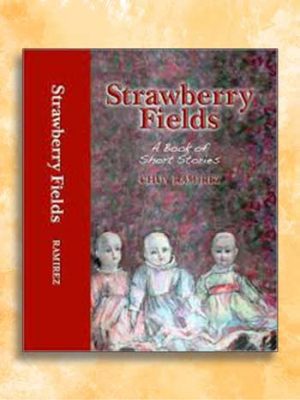Ramirez centers his book on Joaquin, who is the antithesis of another Joaquin of Latino literary fame, the Joaquin in Chicano pioneer author Corky Gonzalez’ epic poem, “I Am Joaquin/Yo Soy Joaquin” (1964). Whereas the latter Joaquin railed against the oppression of Chicanos by Anglos and asserted his Mexican ethnic pride, Ramirez’ Joaquin, an American-born child of the 1960’s, feels strong ambivalence about his Mexican heritage. Strawberry Fields is as much an examination of a bi-cultural person’s inner struggles regarding ancestral and adopted homelands as it is of this particular character’s coming of age in America.
The book covers several decades of Joaquin’s life. We see him as a young boy trying to navigate the temptations and mischiefs of childhood under his mother Manda’s caring, watchful eyes and his father’s stern stare. We see him as an adolescent with years of experience under his belt as a migrant farm worker, traveling with his mother and siblings in caravans of trucks through the Midwest and other states with crops to harvest. We see him in adulthood as a successful attorney in Texas, his home state, haunted by recurring dreams connected to his adolescence and the strawberry fields of Michigan. These fields thus become symbolic on many levels: symbolic of Joaquin’s family struggles with poverty and his disaffection with his lot in life; symbolic of the carefree childhood moments he salvaged in the migrant camps when he and his brother could savor moments of freedom and exploration; symbolic of his eventual rejection of his cultural roots and thus, of his father.
Throughout Joaquin’s life, his father, Benancio, looms as a figure that puzzles him, chastises him, and stirs elemental struggles between them involving love and hate, and culture clashes that cut to the bone. Benancio is a proud Mexican, his hubris and stubbornness turning him into a disapproving parent who beats his children for mild transgressions, who calls them derogatory names, and who can never be pleased. As a major antagonist in the book, Benancio represents to his sons the backwardness of a country and a culture they cannot embrace, as their father wants them to do. Their rejection of his culture, of his beloved Mexico, is ultimately their rejection of him, from which the unflinching Benancio can never recover, and for which he can never forgive them. He abandons his family, leaving them to wonder for most of their lives where he went and why he couldn’t love them.
Besides his father, the key figures in Joaquin’s life are his mother Manda and his two siblings: Bennie, his younger brother; and his sister, who is simply called “Sis” in the book. Manda is a strong, patient woman born in America but closely attached to immigrants through her family’s business. She is attracted to the tall, taciturn, handsome Benancio, whom she meets while at work one day and eventually decides to marry. Despite her children’s conflicts with their father, and his seeming lack of tenderness toward her, Manda is devoted to Benancio, even after he abandons his family. As the matriarchal touchstone, Manda is defined by the extreme sacrifices she makes for her children in the name of progress, their progress, their future. Her gentleness and understanding are but an undertone throughout the book; but toward the end, we realize the extent of her sacrifices for her beloved family.
Bennie, who is very close to Joaquin, grows up to become a school principal, a man with a vivid memory that serves as Joaquin’s link to his past. The studious Sis, sheltered from the hardships of the migrant life once she reaches adolescence, is largely in the background but serves as a stabilizing voice of reason and neutrality. She becomes a teacher and, in her adulthood, reminisces with her brothers about their father’s whereabouts and their checkered family history.
The book shifts continually between the present and the past, taking us from Joaquin’s struggles as an adult, to those of his childhood, to those he survived as a teenager, and so on in loops and flashbacks that keep the book non-linear throughout. Dreams and nightmares are strategically interwoven into key interludes, so that the reader’s curiosity is piqued, and the pace of the narrative is kept brisk and exhilarating. As the book marches toward its climax, the chapters are even more non-linear, with scenes alternating between the past and present more rapidly as Joaquin gains clarity and insights about his experiences in the strawberry fields and about his identity as a man and as a son.
A compelling sub-plot involves a beautiful, blonde girl of mixed heritage named Belinda who, early in the book, has disappeared. She then is absent for a good portion of the book until the adolescent Joaquin and his family are preparing to travel to the Midwest for harvesting. Joaquin sees her from a distance in one of the migrant workers’ groups and develops a crush on her, but his memory of her fades with time. We catch glimpses of Belinda throughout the book, but these are surrealistic scenes, chopped up and fuzzy, as incomplete memories can appear to be in reality. When the adult Joaquin is haunted by dreams of Belinda, which depict her with bloody wounds and missing eyes, he fears that he is somehow connected to her disappearance, and this may be why his mind has blocked out recollections of her.
But this is another piece of the puzzle that Joaquin must solve. Belinda’s fate, on a subconscious level, is another reason that the adult Joaquin journeys from his home in Texas to the strawberry fields of Michigan, to revisit them, to seek something that even he is unaware of. In the final chapters of the book, with the strawberry fields drastically changed 30 years after he worked them, and the migrant workers’ camp by the fields totally gone, Joaquin can only rely on his faint memories, his emotions, his dreams, and the present scenes that repel him to derive meaning from his experiences. What happened to Belinda? Why did his father abandon him? Two burning questions—distinct from one another but critical to understanding who he, Joaquin, is—come together upon his revisitation of the strawberry fields. In a climactic epiphany, Joaquin discovers the answers to both questions.
The author’s language in these final scenes and throughout the most critical scenes is poignantly vivid and sometimes heart-rending. Ramirez is deft with his descriptiveness, particularly in the second half of the book. In describing the Michigan of the 1960’s, for example, the first time Joaquin’s family migrated there to harvest crops, Ramirez writes:
…where life seemed almost perfect among the solitude of a spacious rural America, where topsoil was measured in feet and little boys dreamed of playing high school basketball and little girls dreamed of becoming homecoming queens….a land inhabited by fattening cattle and red barns and grain elevators, and uniquely confident, stoic men…whose canvases were the sky and the open spaces on which they never tired of creating green and lush symmetry (p. 218).
It is as if Ramirez warms up exponentially as the book unwraps and reveals its treasures to us. One wonders if the beginning parts were those written by Ramirez at the start of his decade of birthing this book. One wonders if the latter chapters indeed came later in the decade; and, if so, the beauty of the language, the depth of the insights in the final chapters, the power of Joaquin’s catharsis are rightfully the end products of much labor…not lost, as Shakespeare wrote, but of labors reaching their fruitful, magnificent conclusion.
Ramirez calls his work “a book of Short Stories.” If these are indeed stories (rather than chapters of a novel), then they can be said to employ intertextuality, or the literary technique of repeating characters and places from one story to another. This technique marked pioneer Chicana author, Estella Portillo de Trambley’s, short stories in her classic book, Rain of Scorpions and Other Stories (Bilingual Press, Revised Edition, 1993), as scholars Vernon E. Lattin and Patricia Hopkins described in their Introduction to that edition.
The technique was successful for Trambley’s purposes and won her admiration for her work. Similarly, Ramirez has woven his separate “stories” into a loosely-unified book, a hybrid novel to some, but clearly a tapestry of humanity that we can all relate to and embrace.






